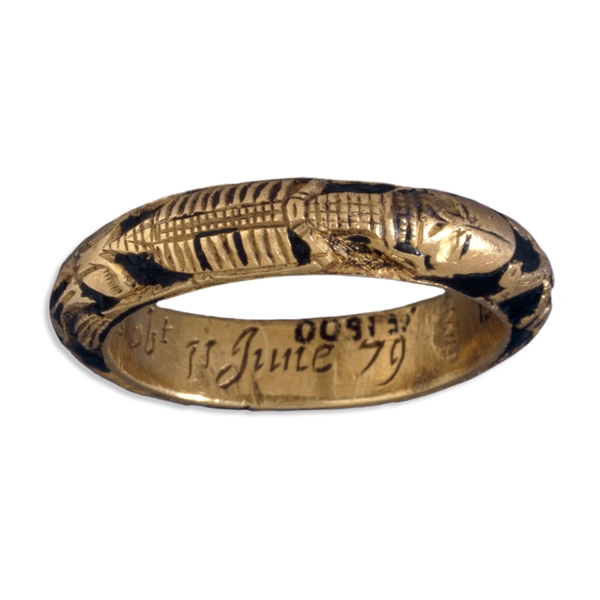Study Guide Death

Table of Contents
Mourning Rings
 While Puritans did not sanction the use of wedding rings, mourning rings were commonly used to commemorate the dead, particularly at the funerals of the wealthy. These rings were an important means of cementing ties to kin and the community on behalf of the dead and the surviving mourners: they were most commonly given to family members and to people of high social standing, though some were given to friends. Minister Samuel Sewall received fifty-seven mourning rings between 1687 and 1725. Colonists valued the rings greatly and cherished the rings as mementos of lost friendships; rings were left to heirs and common acquaintances. To a certain extent, the rings served to redistribute the wealth of the dead to the community, since the rings might be worth as much as £1 apiece, and sometimes between fifty and two hundred rings might be distributed at a funeral (Earle 197-99). Other items that were commonly given away at funerals include gloves, broadsides, and handkerchiefs.
While Puritans did not sanction the use of wedding rings, mourning rings were commonly used to commemorate the dead, particularly at the funerals of the wealthy. These rings were an important means of cementing ties to kin and the community on behalf of the dead and the surviving mourners: they were most commonly given to family members and to people of high social standing, though some were given to friends. Minister Samuel Sewall received fifty-seven mourning rings between 1687 and 1725. Colonists valued the rings greatly and cherished the rings as mementos of lost friendships; rings were left to heirs and common acquaintances. To a certain extent, the rings served to redistribute the wealth of the dead to the community, since the rings might be worth as much as £1 apiece, and sometimes between fifty and two hundred rings might be distributed at a funeral (Earle 197-99). Other items that were commonly given away at funerals include gloves, broadsides, and handkerchiefs.
Mourning rings, like gravestones, present a microcosm of Puritan views on death and dying. The rings were typically gold enameled in black, and they often bore the figure of a death’s head, a coffin with skeleton, and a favorite motto. The ring at right from the British Museum belonged to John Lee Warner (1679), the Archdeacon of Rochester. It features a a skull and cross-bones appear and the tag "MEMENTO MORI" (In remembrance of death). Rings in America were in a similar style. The ring of Reverend Edward Wigglesworth (1731-1794) in the collection at Massachusetts Historical Society (1), for example, features a crystal cut in the shape of a coffin laid over a gold paper skeleton. Wigglesworth was a distinguished Hollis Professor of Divinity at Harvard College, and the grandson of minister Michael Wigglesworth who had authored the popular Puritan poem “The Day of Doom.” We similarly find a gold paper skull overlaid with a cut crystal on the ring commemorating little John Gray, who died when only six days old (2). This ring is a somewhat solemn reminder of the poet Michael Wigglesworth’s warning that even the youngest of infants were sinners, and the best they could hope for was “the easiest room in hell.” Many of the rings of this era reflected the marriage of hope and despair in Puritan views on the afterlife: winged death’s heads , for example, represented both the ability of the soul to rise up, and the decay of the human form. Some rings took the form of a serpent consuming its tail, signifying the devouring nature of time and sin (Earle 198-99).
Notes
(2) Anonymous, John Gray Mourning Ring (1763). Massachusetts Historical Society, Artifact no. 0046. “J. GRAY./.OB:17.SEP/.1763.AE 6D”
Items Related to Mourning Rings in the Archive
Funeral Sermons < Previous | Next > Weaned Affections